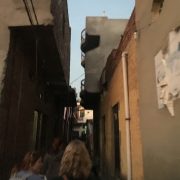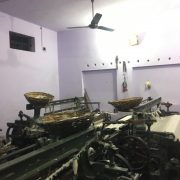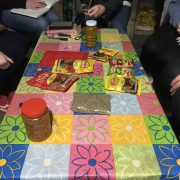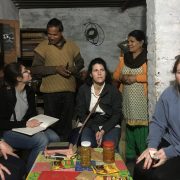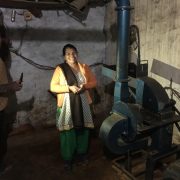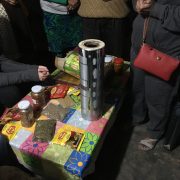On our 8th full day in India, we got an early start and visited the fields of Dayalbagh Educational Institute (DEI). These fields are tended to both by students at the institute and volunteers from the local community that serve there for religious reasons. We learned that children from 3 months to 3 years old are allowed to come volunteer with their parents. This exposes the process to these children allowing them to better understand the Earth and nature and begins the act of passing this practice along to the next generation. While visiting the fields, we were given the opportunity to meet with and present a gift to the leader of the community that tends to the DEI fields. He is a very influential man, and those in his community seek out his advice. He is currently dealing with some health issues and had not come to the fields the day prior, so we were very fortunate to have been able to meet him and share our purpose with him.
After visiting the fields, we returned to the hotel to gather our belongings and then began our drive to Meerut. Once in Meerut, we met with a woman who started a non-governmental organization focused on helping women in rural areas. Women in these areas are often interested in starting some sort of business or growing the business they already have. In order to do this, they need money. However, they are often unable to get a loan from the bank due to a lack of assets. This leads these women to seek out money from those within their community. They are usually unable to pay these individuals back. This leads to a debt cycle that these women are usually unable to get out of. To break this cycle, she connects families to one another that are wanting to begin/already are in business. She connects a minimum of 4 families and a maximum of 10. Once connected, these families are able to combine their resources and begin a business. Then, to supplement these resources, she guides them through the process of applying for low interest loans from the National Bank for Agriculture and Rural Development. With these loans, these families are able to truly get their business going by doing things such as purchasing necessary machines.
After our brief meeting with the leader of this NGO to understand the basics of what she does, we traveled to two of her sites. The first site was a weaving business located in a portion of someone’s home. This business was formed by 5 families that joined together to form a joint liability group. These families are Muslim and have been in the business of weaving for numerous generations. However, they are struggling to keep up with the current, modern times. In order to keep up, these families needed a loan to get power looms. When they received their loan, they were able to purchase 5 power looms. They run these looms 24/7 in order to weave the cotton threads they buy locally. They then sell the fabric they weave locally to those that will print on it. Unfortunately, the business is not making a profit yet; they are operating at a loss. They are making enough to survive though. (Pictures 1 & 2; Video 1)
The second site we visited was a spice and pickling business. Owned by a woman named Anita and her husband and operated out of their home, this business has been active for 2 years. They employ 12 women and buy local products such as turmeric that they grind, package, and then sell. They also pickle various fruits and vegetables such as mangos. The women that Anita and her husband employ work eight hours a day and earn $100 a month. The unique thing about this business is that they have a brand-named Daisy. With a brand and glossy packaging, they are able to gain some recognition in the market and then sell more of their goods. It is this branding and packaging that creates their need for a loan. Specifically, the metal printing cylinder that allows them to produce their packaging costs 100,000 rupees which is approximately $1600. While Anita and her husband are able to sell all of their goods year-round, certain products that they purchase and then grind or pickle experience price fluctuations during periods of the year. To account for this, Anita and her husband will stock up on certain goods when the prices are low to ensure they have and are able to sell their product when the price of that good fluctuates upward. Anita and her husband were also willing to share some of their struggles with us. One of those is that with the business being located in their home, there are some sacrifices on their part to allow for this loss of living space. Also, since land is so expensive, expanding or moving the business proves to be very difficult. Another one of their struggles is they currently do not have a car. This makes the transportation of goods to the market difficult. They currently use a cart; and a car would make this process quicker and safer. Overall, it was a great experience to be allowed in to these people’s home and see how they are making their living. (Pictures 3-6)
Newspapers:
Over the course of the program, I looked at several newspapers. One of the first things I noticed was that these papers were almost daily reporting about something Trump said, did, or tweeted. More often than not, these were not positive stories as in they did not portray our country and its president in a positive light. This makes me concerned for how other countries are coming to perceive the United States based solely on the rash, uniformed, pompous manner in which our leader speaks and acts. As for the newspaper overall, there were numerous stories about deaths, murders, and various accidents. While this may be in line with the current state of other countries and the world, it did give the whole newspaper a depressing vibe. In particular, there was at least one story of someone committing suicide due to their inability to get out of debt. We had heard about this happening in general from a professor at Delhi University who spoke to us about Indian agriculture as a whole. Reading about it in the newspaper made it very much more real. This allowed me to better understand the problem and appreciate those that are helping individuals avoid such debt such as those working for the NGO we visited. In regards to agriculture in the newspaper, the only stories I found talked about various struggles that farmers and the industry are facing. One story that I found on the online version of the Indian Times spoke of how climate change is harming farmers and causing lower rice yields. Another story I read discussed how a farmer was having difficulty finding a wife for his son, also a farmer, due to people not wanting their daughters to marry a farmer. These stories just again highlight the struggles that Indian farmers and their industry are facing.
- Pathway to first home
- Site with power looms
- Some daisy brand products
- Anita and her husband discussing their products
- Anita showing us the grinding machine
- Cylinder used to produce the Daisy packaging
